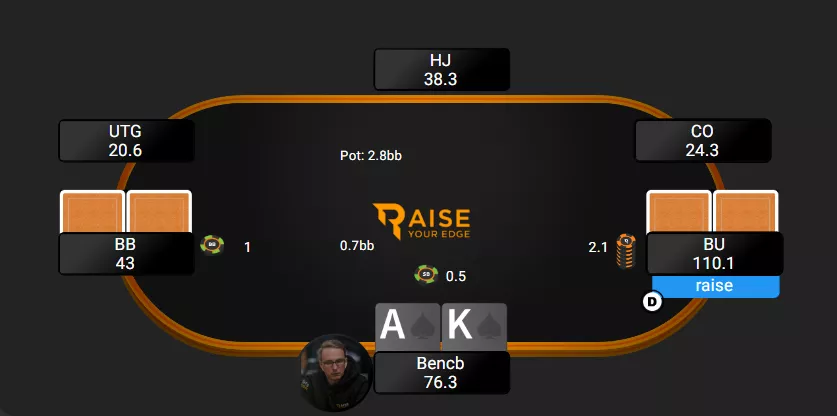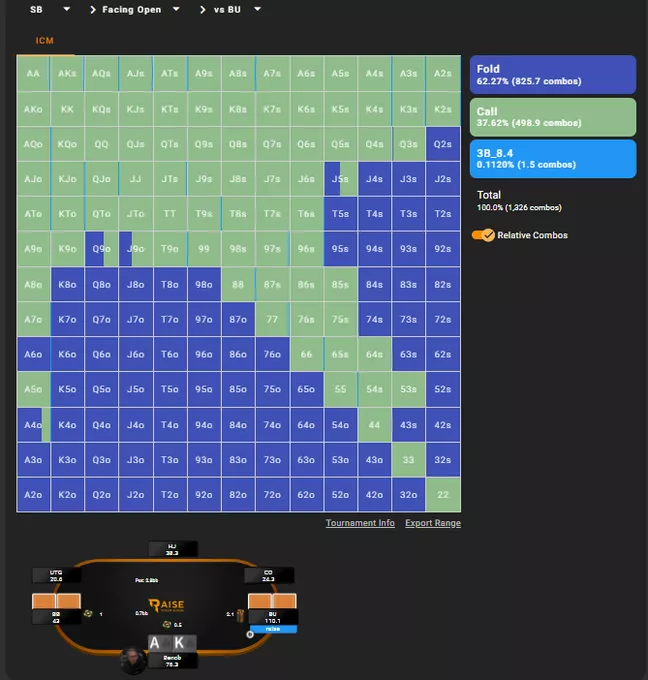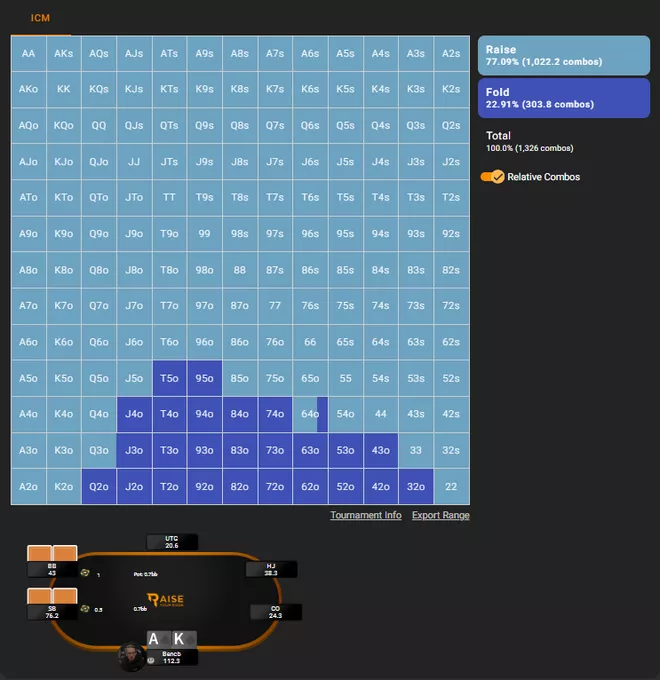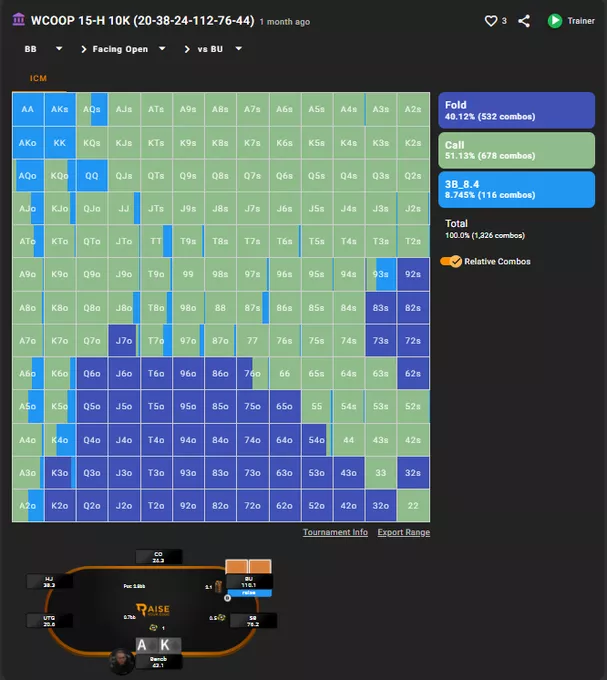Why you should NEVER 3-bet in a spot like this.

Final table. Almost all top regs play incorrectly in this situation. This is a pretty extreme ICM spot. Sometimes it's not wrong to 3-bet here, but your decision should primarily be based on how your opponents are playing. It is very important to understand the theory and be able to apply it correctly in practice.
This is how we should play the solver:

In such a spot there is simply a huge risk premium.
Consider all possible scenarios for playing a 3-bet pot out of position – with AA, A5s, AK, JTs, or any other hand you might want to 3-bet with.
It is unlikely that you will lose the entire stack; to do this, you must be dealt a real setup, for example, set under set, even an overpair will not be enough. With one pair, it is best to play pot control, since it is too rare for a board to open on which we have a combination with potential for the nuts.
By default, calling with any cards is better than 3-betting. Once again, I’ll make a reservation, if you know that your opponent 4-bet too often, then you can play 3-bet with +/ and just shove on his 4-bet (such 3-bet/pushes can sometimes be diluted with A5s, A4s, etc.)
But the calling range here is very wide. This is explained by the fact that the button will open so many hands that it is profitable to call even with Q4s and something similar.
 Raising range from the button
Raising range from the buttonThe best strategy against this range is to play a lot of small pots. No one will put you on and , at the same time you are setting a trap against a possible squeeze from the BB. I'm not advocating playing this way all the time, but it is very important to have a general understanding of this strategy and make adjustments depending on specific conditions.
A BB with a 44-blind stack will 3-bet a lot more because he isn't risking as much as the SB.

Key findings:
– A chip leader with a huge stack opens about 80% of hands.
– When there are several players with shorter stacks at the table, and the second chip leader is almost guaranteed to be in the top 3, he should almost always call after the chip leader raises.
– In any such situation with a 50bb+ stack, you need to be calling with a very wide range.
Minimizing variance is especially important in weak final tables. You will win a lot of pots with simple open raises and continuation bets. And by 3-betting you will only put yourself in a difficult situation that is completely unnecessary. Play smart!
Not everyone liked this strategy.
Finnish top reg Pauli "Fiilismies" Ayras hinted that he would not play like that even under torture:
“If you ever see me in a situation like this choosing anything other than trying to load as many chips into the pot preflop as possible, just take me out of the room and tell me it’s time to call it a day.”
Arunas Sapitavičius found holes in Ben's conclusions:
– I’m not saying that AKs is always a raise, but you put some strange 3-bet sizing into the solver. You need to bet more, at least 12bb. Solver doesn't like to play out of position with a small SPR against a tight calling range, which is why even is not 3-betting here. The solver tends to play either small pots against weak ranges, or immediately huge pots when he can place it on the turn.
Sam Greenwood did not go deeper into the theory, but limited himself to a brief comment: “LOL.”
Fedor Holz paid a little more attention to the topic:
– In my opinion this showcases one of the big flaws in working with ICM and understanding the influence of payouts on strategy.
The used model has no proper way of approximating the EV-advantage of a bigstack over the high amount of hands that will be played on average. ICM doesn’t account for anything poker-related, it just attributes your chips a dollar value based on % of scoring each prize based on your % of chips in play.
That would mean that the EV of having 40% of chips in play is always the same given the same payouts and player number, regardless of the stack distribution. Based on your logic, would you agree that to be true?
Ask yourself: what’s the bb/100 of the bigstack here? How many hands on average will he be able to realize this type of EV? On the other side of the coin: whats the upside to take that kind of lead? There’s no particular calculation besides a few hands of FGS you can run and this has tremendous flaws.
ICM is not accounting for that and can sometimes lead to poor decision making.
I think in this hand it’s leading to a too passive approach, because it returns a lower EV to won chips than what I would attribute them.
This doesn’t mean I’d go super crazy here, don’t get me wrong. But I’d argue for not playing this spot too passive.
I think the gist remains though that a lot of players play this spot too similar to chipEV and Ben made a good point pointing that out.
“Calculations of potential EV work both ways,” Bencb answered Fedor. – What will your expectation be if you lose the pot and end up with a 20-30bb stack? In my example, losing our stack would be catastrophic because we have position on the chip leader. So we just call his raises and play a lot of hands in position against his wide range. If the big stack were to our left, the situation would be completely different. I myself am a supporter of aggressive play, but only when it benefits us. This is clearly not the case here. Even the SB versus button situation is not so bad for us, since postflop we will be playing against 80% of the range, and the BB player cannot overcall due to ICM pressure (although this is beneficial for him in chEV).
“That’s why many of you play final tables so poorly,” Ben answered all the critics. – Of course, the title turned out to be provocative;) But the essence of my post is that final tables need to be played thoughtfully, especially when we have a noticeable advantage. There is much more to playing in the finals than preflop GTO ranges. You need to play more hands with the same opponents; others, on the contrary, should be avoided. You need to be able to get MAXIMUM EV on a particular table. But in order to put all this into practice, you need a general understanding of ICM, and only then you can start making adjustments.
Of course, you can 3-bet and lose your stack due to overvaluation , , ... You can even 3-bet K3s to 14bb, because that's what the solver advises. But do not forget that it does not take into account your advantage.
It doesn't really matter if we 3-bet with in a specific example, it is important to have a general understanding that a strategy with a very rare 3-bet or no 3-bet at all is also quite viable. If you're not sure what to do with , , or , calling will definitely not be a mistake. Especially if you are trying to avoid borderline variance spots.
If there are 2-3 weak players among my opponents, I will always play as a call. You can, of course, choose the path of a near-zero GTO player, diversifying your game with 3-bet, but then be prepared to lose almost your entire stack or get busted altogether.
I like my approach better. It has served not only me but also many of my students well for many years.








